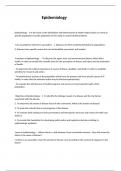Exam (elaborations)
Epidemiology
- Course
- Epidemiology
- Institution
- Epidemiology
Epidemiology - It is the study of the distribution and determinants of health related states or events in specific populations and the application of this study to control health problems. Two assumptions inherent in epi studies - 1. Diseases are NOT randomly distributed in populations. 2. D...
[Show more]



